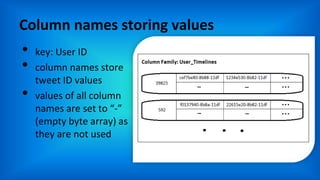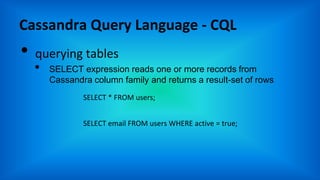Cassandra
- 1. Prepared by, Pooja G.V 8th sem, CSE GECH.
- 3. • Cassandra is a distributed database from Apache that is highly scalable and designed to manage very large amounts of structured data. •It provides high availability with no single point of failure.
- 4. • Open-source database management system (DBMS) • Several key features of Cassandra differentiate it from other similar systems Continued.....
- 5. History of Cassandra ● Cassandra was created to power the Facebook Inbox Search ● Facebook open-sourced Cassandra in 2008 and became an Apache Incubator project ● In 2010, Cassandra graduated to a top-level project, regular update and releases followed
- 6. Motivation and Function ● Designed to handle large amount of data across multiple servers ● There is a lot of unorganized data out there ● Easy to implement and deploy ● Mimics traditional relational database systems, but with triggers and lightweight transactions ● Raw, simple data structures
- 7. General Design Features Emphasis on performance over analysis ● Still has support for analysis tools such as Hadoop Organization ● Rows are organized into tables ● First component of a table’s primary key is the partition key ● Rows are clustered by the remaining columns of the key ● Columns may be indexed separately from the primary key ● Tables may be created, dropped, altered at runtime without blocking queries Language ● CQL (Cassandra Query Language) introduced, similar to SQL (flattened learning curve)
- 8. Peer to Peer Cluster • Decentralized design • No single point of failure • No bottlenecking
- 9. Fault Tolerance/Durability Failures happen all the time with multiple nodes ● Hardware Failure ● Bugs ● Operator error ● Power Outage, etc. Solution: Buy cheap, redundant hardware, replicate, maintain consistency
- 10. Fault Tolerance/Durability • Replication • Distribution of data to multiple data centers
- 11. Performance • Core architectural designs allow Cassandra to outperform its competitors • Very good read and write throughputs
- 12. Scalability Read and write throughput increase linearly as more machines are added “In terms of scalability, there is a clear winner throughout our experiments. Cassandra achieves the highest throughput for the maximum number of nodes…” - University of Toronto
- 13. Comparisons Apache Cassandra Google Big Table Amazon DynamoDB Storage Type Column Column Key-Value Best Use Write often, read less Designed for large scalability Large database solution Concurrency Control MVCC Locks ACID Characteristics High Availability Partition Tolerance Persistence Consistency High Availability Partition Tolerance Persistence Consistency High Availability
- 15. Netflix • online DVD and Blu-Ray movie retailer • Nielsen study showed that 38% of Americans use or subscribe to Netflix
- 16. Netflix: Why Cassandra ● Using a central SQL database negatively impacted scalability and availability ● International Expansion required Multi- Datacenter solution ● Need for configurable Replication, Consistency, and Resiliency in the face of failure ● Cassandra on AWS offered high levels of scalability and availability Jason Brown, Senior Software Engineer at Netflix
- 17. Hulu • a website and a subscription service offering on-demand streaming video media • ~30 million unique viewers per month
- 18. Hulu: Why Cassandra • need for Availability • need for Scalability • Good Performance • Nearly Linear Scalability • Geo-Replication • Minimal Maintenance Requirements Andres Rangel, Senior Software Engineer at Hulu
- 19. Reasons for Choosing Cassandra • Value availability over consistency • Require high write-throughput • High scalability required • No single point of failure
- 20. CAP Theorem
- 22. • Cassandra is a column oriented NoSQL system • Column families: sets of key- value pairs • A row is a collection of columns labeled with a name Key-Value Model
- 23. Cassandra Row • the value of a row is itself a sequence of key-value pairs • such nested key-value pairs are columns • key = column name • a row must contain at least 1 column
- 25. Column names storing values • key: User ID • column names store tweet ID values • values of all column names are set to “-” (empty byte array) as they are not used
- 26. • A Key Space is a group of column families together. It is only a logical grouping of column families and provides an isolated scope for names Key Space
- 27. Comparing Cassandra (C*) and RDBMS • with RDBMS, a normalized data model is created without considering the exact queries • with C*, the data model is designed for specific queries • C*: NO joins, relationships, or foreign keys
- 28. Cassandra Query Language - CQL • creating a keyspace - namespace of tables CREATE KEYSPACE demo WITH replication = {‘class’: ’SimpleStrategy’, replication_factor’: 3}; • to use namespace: USE demo;
- 29. Cassandra Query Language - CQL • creating tables: CREATE TABLE users( CREATE TABLE tweets( email varchar, email varchar, bio varchar, time_posted timestamp, birthday timestamp, tweet varchar, active boolean, PRIMARY KEY (email, time_posted)); PRIMARY KEY (email));
- 30. Cassandra Query Language - CQL • inserting data INSERT INTO users (email, bio, birthday, active) VALUES (‘john.doe@bti360.com’, ‘BT360 Teammate’, 516513600000, true);
- 31. Cassandra Query Language - CQL • querying tables • SELECT expression reads one or more records from Cassandra column family and returns a result-set of rows SELECT * FROM users; SELECT email FROM users WHERE active = true;
- 33. • perfect for time-series data • high performance • Decentralization • nearly linear scalability • replication support • no single points of failure • MapReduce support Cassandra Advantages
- 34. Cassandra Weaknesses ● no referential integrity ● querying options for retrieving data are limited ● sorting data is a design decision ● no support for atomic operations ● first think about queries, then about data model
- 35. Cassandra: Points to Consider ● Cassandra is designed as a distributed database management system ● Cassandra write performance is always excellent, but read performance depends on write patterns ● having a high-level understanding of some internals is a plus
- 36. References • Lakshman, Avinash, and Prashant Malik. "Cassandra: a decentralized structured storage system." ACM SIGOPS Operating Systems Review 44.2 (2010): 35-40. • Hewitt, Eben. Cassandra: the definitive guide. O'Reilly Media, 2010. • http://www.datastax.com/documentation/cassandra/2.0/cassandra/architecture/a rchitectureTOC.html • http://www.slideshare.net/planetcassandra/a-deep-dive-into-understanding- apache-cassandra • http://www.slideshare.net/DataStax/evaluating-apache-cassandra-as-a-cloud- database • http://planetcassandra.org/functional-use-cases/ • http://marsmedia.info/en/cassandra-pros-cons-and-model.php • http://www.slideshare.net/adrianco/migrating-netflix-from-oracle-to-global- cassandra • http://wiki.apache.org/cassandra/CassandraLimitations
Editor's Notes
- #6: It combines Amazon Dynamo’s fully distributed design with Google Bigtable’s column-oriented data model.
- #7: designed to handle large amounts of data across many commodity servers, providing high availability with no single point of failur
- #16: offering streaming movies through video game consoles, Apple TV, TiVo and more http://www.usatoday.com/story/life/tv/2013/09/18/netflix-hulu-amazon-nielsen-viewership-data/2831535/
- #17: Central Oracle database -> everything in one place, convenient until it fails Schema changes required downtime Cassandra stores 3 local copies, 1 per zone Synchronous access, durable Replicates at destination Global Coverage business agility Local Access better latency fault isolation
- #19: Geo-Replication – distribution of data across multiple regions
- #29: SimpleStrategy is a replication strategy. There are two: SimpleStrategy and NetworkTopologyStrategy. SimpleStrategy is used for simple data center clusters. It is default. NetworkTopologyStrategy is used for multi-datacenter deployments
- #30: Table – when schema is static Column Family – when schema is dynamic
- #35: No join or subquery support, and limited support for aggregation. This is by design, to force you to denormalize into partitions that can be efficiently queried from a single replica, instead of having to gather data from across the entire cluster. Ordering is done per-partition, and is specified at table creation time. Again, this is to enforce good application design; sorting thousands or millions of rows can be fast in development, but sorting billions in production is a bad idea.
- #36: It’s important to analyze how you are going to query your data. Spending time to design your schema around your query pattern can save a lot of hassle debugging performance issues while also ensuring that you can scale easily. Additionally, having a high-level understanding of some of the internals such has how deletions are implemented, how secondary indices operate, and when to use the row cache can go a long way in designing a strong application built atop Cassandra.



































